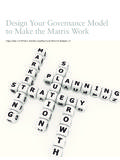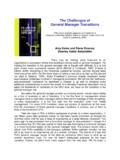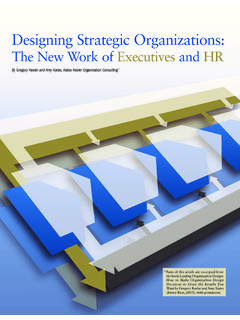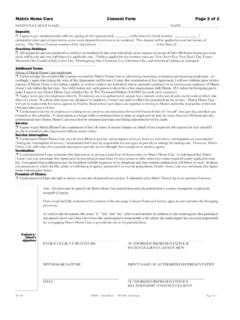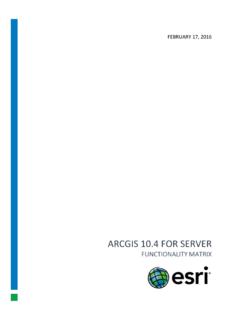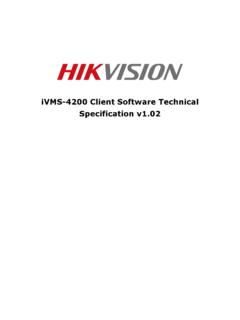Transcription of VIRTUAL COLLABORATION IN A MATRIX …
1 VIRTUAL COLLABORATION IN A MATRIX organization (Chapter in The Handbook of High Performance VIRTUAL Teams, 2008) Amy Kates and Paul J. Erickson The MATRIX structure is an increasingly common feature on the business landscape. As firms grow more complex and more geographically dispersed, leaders are confronted with the question of how to effectively integrate and align staff that work in remote locations and need to be deployed on several projects simultaneously. The need to integrate resources and reconcile opposing objectives creates the challenge of designing mechanisms that will foster true COLLABORATION , instead of simple compromise.
2 As a result, in an attempt to achieve multiple strategic objectives with the smallest number of resources, many organizations are using MATRIX reporting relationships as a way to link disparate parts of the organization and encourage COLLABORATION . Use of a MATRIX presents a dilemma, however. Three decades of study of the MATRIX in organizations have shown that it is one of the most powerful ways to force interaction among business units and integrate the diverse parts of an organization . At the same time, experience has demonstrated that it is most successful in organizations that already have a strong foundation of teamwork, joint accountability, and the management processes that support COLLABORATION .
3 Therefore, organizations that shift to the MATRIX in order to get the promised benefits without putting in place the required enabling and support mechanisms, quickly find that they have introduced complexity, confusion, and frustration without achieving the expected gains. Predictably, they soon revert back to a simpler configuration, adding another example to the many that have abandoned the MATRIX as just too hard to do. The reality is that most businesses today are complex. They need to serve multiple products, markets, and geographies and, if they are to reap the rewards of growth and scale, they need to integrate laterally and find synergies among all the various dimensions of the business.
4 Complex business models result in complex organizations, including MATRIX relationships. And the organizations that can best manage this complexity without making it burdensome to either customers or front-line employees gain competitive advantage. The complexity created by the MATRIX is usually borne by the middle manager who provides the connections between all of the various strategic dimensions that the business is trying to achieve. Attention to organization design does not remove complexity for these managers, but it can help ensure that the organization is an enabler instead of a barrier to these managers as they try to achieve the required business results.
5 Page 1. Implementing a MATRIX is a significant leadership decision, and not one to make lightly. This chapter summarizes what has been learned about designing and implementing a successful MATRIX with a focus on VIRTUAL environments. The chapter will address using a MATRIX to bridge the barriers of time and space as well as the challenges of introducing added complexity for teams and managers working remotely. The intent is to demystify this much maligned organizational form and offer tools to maximize the chance of successful implementation. WHAT IS A MATRIX ? Strictly speaking, a MATRIX is an organization in which various employees have two or more bosses.
6 It was pioneered in the aerospace and defense sectors in the 1960s and 1970s in response to expansions of scope and complexity represented by initiatives such as the space program (Peters & Waterman, 1982). For example, an engineer at Boeing working on the development of the 747 airliner might have reported into the manufacturing group, but might also have reported to a manager in the commercial aviation product division. In making the engineer accountable to both supervisors, the goal was to maintain robust functional expertise while deploying resources where they were most needed.
7 Soon, firms in other sectors experimented with using the MATRIX , with mixed results. In the early 1980s, following Tom Peters and Robert Waterman's claim in In Search of Excellence that no excellent companies used a MATRIX design, it was largely abandoned as overly complex, rigid, and cumbersome (Peters & Waterman, 1982). The mid-1990s saw the MATRIX return to favor. One driver behind this trend was the need to hold down costs for example, having a systems analyst report to a local functional manager in New York as well as a product manager in Hong Kong meant that the Hong Kong office would not have to hire a systems analyst of their own.
8 Having the same person working on projects for New York and Hong Kong simultaneously also meant a greater degree of cross-border standardization, which might promote further cost savings. A second driver has been globalization. Outsourcing and off-shoring to low-cost manufacturing and processing centers has left North American and European companies with mostly knowledge-based, project-centered work precisely the conditions that rely on high levels of VIRTUAL COLLABORATION and lateral integration. Despite its reemergence, MATRIX is still a code word among many observers of organizational life for cumbersome and over-engineered.
9 The Economist, in a major feature on The New Organisation, derides it as the corset from which many companies are still struggling to free themselves (Hindle, 2006). Yet today matrices can be found in most large companies. Rarely is a MATRIX used as the overall framework. More frequently, it is used to tie together key roles and ensure that decisions made take multiple business perspectives into consideration. Often, the research and development function is configured as a MATRIX . Researchers belong to specialist groups, but take part in projects that bring them together in cross-functional teams.
10 Other examples can frequently be found in sales functions. Sales Page 2. departments are usually structured into regions in order to minimize travel time and exploit local knowledge. However, national accounts, global product lines, distribution channels (such as resellers and retailers) frequently cut across these regions. In order to coordinate along the customer, product, and channel dimensions as well as the geographic, sales managers may report to two managers in order to ensure a focus on both aspects of the business. A Case Example To illustrate the concepts and tools for designing a MATRIX , a typical example based on a large bank's information technology (IT) group is presented below.
